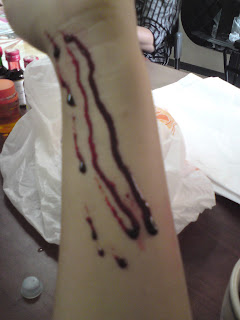Today, 21st of Feb,we make a blood from the thing that we can eat... it was an interesting experience for me and my frends...have a look...
This 2 pictures are the blood that i made. The ingredients are:
GOLDEN SYRUP
BLUE COLORING
RED COLORING
Notch effect?bite effect?Decide this yourself..huhu..
Vampires eat people???
Oh no!!my finger is missing!!
raisins..nyum-nyum??...aaa...
Are they look real???im also used raisins to make the wounds. The missing finger is belong to Kerol...huhu..look very real dow...;)





















